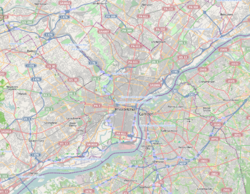Pennsylvania School for the Deaf
|
Pennsylvania Institute for the Deaf and Dumb
(former site) |
|
 |
|
| Location | 7500 Germantown Ave., Philadelphia, Pennsylvania |
|---|---|
| Coordinates | 40°3′49″N 75°11′47″W / 40.06361°N 75.19639°W |
| Built | 1820 |
| Architect |
Wilson Brothers & Company Cope & Stewardson |
| Architectural style | Late Victorian |
| NRHP Reference # | 85000999 |
| Added to NRHP | May 9, 1985 |
The Pennsylvania School for the Deaf is the third-oldest school of its kind in the United States. Its founder, David G. Seixas (1788–1864), was a Philadelphia crockery maker-dealer who became concerned with the plight of impoverished deaf children that he observed on the city's streets. The current school building is listed by the National Register of Historic Places, and two former campuses are similarly recognized.
It is one of four approved charter schools—along with the Western Pennsylvania School for Blind Children, the Overbrook School for the Blind, the Western Pennsylvania School for the Deaf—in Pennsylvania for blind and deaf children.
In 1819, Seixas began bringing deaf youngsters into his home to provide them with food, clothing and instruction, all at his expense. More space became needed to accommodate additional children as Seixas' humanitarian efforts became known, so he rented an office at the southeast corner of Eleventh and High (later Market) Streets to serve as a school. In 1821, prominent Philadelphia citizens decided to help Seixas by incorporating a charitable society: the Pennsylvania Institution for the Deaf and Dumb. The organization was chartered by the Commonwealth of Pennsylvania as "an asylum and school in the city of Philadelphia, where the children of the rich, for a moderate compensation, and of the poor, gratuitously, laboring under the privation of the faculty of speech, are maintained and educated." (Act of the Pennsylvania General Assembly, February 8, 1821) The state also provided financial assistance. Episcopal Bishop William White served as the school's president until his death in 1836.
The number of deaf children needing special education increased so much that a much larger school—more accurately, an asylum—was soon needed. This became the stately Greek Revival structure that still stands at the northwest corner Broad and Pine Streets. Completed in 1826 and later incorporating two additions, this building is an excellent example of major works by three of America's most important 19th-century architects: John Haviland, William Strickland and Frank Furness. When the Pennsylvania School moved to a 70-acre (280,000 m2) campus in Philadelphia's Mount Airy neighborhood in 1892-1893, the Broad and Pine building was purchased by the predecessor of Philadelphia's University of the Arts. The structure, now known as Dorrance Hamilton Hall, is the oldest extant edifice on Broad Street.
...
Wikipedia



